Nestled amidst the vibrant city of Jaipur, the Jawahar Kala Kendra stands as a testament to the rich cultural heritage of Rajasthan. This architectural marvel was designed to foster creativity and showcase various art forms. Additionally, it has become a hub for artists, performers, and art enthusiasts worldwide. With its multiple exhibits and art shows, it is one of the best museums in Jaipur.
By far one of my favorite places to visit in the Pink City of India, it spans over 9.5 acres of land, making it one of the largest multi-arts centers in the country. Moreover, it serves as a cultural and educational hub, providing a platform for artists, students, and visitors to engage with the arts in diverse forms.
In this blog, I discuss the stunning architecture, the significance of Jawahar Kala Kendra in Jaipur, the visionary architect behind its creation, and the diverse events within its walls.
Quick facts about the Jawahar Kala Kendra in Jaipur:
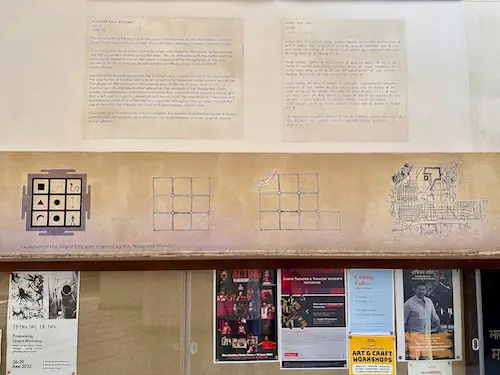
Below are some quick facts about the Jawahar Kala Kendra in Jaipur, its art exhibits, and the museums on site.
- Operating Hours of Jawahar Kala Kendra: 10 am to 6 pm, Monday to Friday. It is closed on Saturday and Sunday.
- Cost of Entry Ticket for the Jawahar Kala Kendra: It is free to enter the Jawahar Kala Kendra
- Location: 2, Jawahar Lal Nehru Marg, Opposite Opp Commerce College, Jhalana Doongri, Jaipur, Rajasthan 302004
- Where to find out about Exhibitions: The official Jawahar Kala Kendra website publishes events on their calendar; you can see their monthly calendar here.
- Time Needed to Visit the Jawahar Kala Kendra: About 2 hours. It will also depend on which exhibits are shown and how many displays are shown.
History of the Jawahar Kala Kendra:
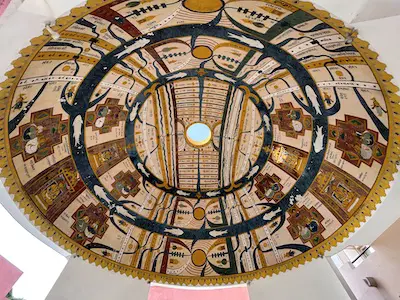
In the rich tapestry of Indian art and heritage, a pressing need emerged to nurture and support artists and their creative expressions. The Jaipur International Multi-Art and Cultural Center (Jawahar Kala Kendra or JKK) was established to respond to this demand. The construction of the JKK began in 1986 and was completed in 1991. The Rajasthan Government commissioned the building, and was finally opened to art and cultural enthusiasts in 1993.
In recent years, JKK has emerged as a popular cultural destination, a reference point for emerging art and cultural centers. Through its wide range of activities, including workshops, dance and music performances, theater shows, art exhibitions, and publications focused on art and culture, JKK brings to life the artistic minds of many inspiring artists. By facilitating interactions between art connoisseurs, scholars, artists, and visitors, JKK fosters a sense of communion and collaboration, allowing them to explore the intricate and intrinsic aspects of art and culture in Rajasthan.
Throughout its existence, Jawahar Kala Kendra has established itself as a hub for artistic endeavors, where classical and folk traditions seamlessly converge. After more than two decades, JKK stands as a dynamic center with immense potential to cater to tradition and innovation. Embracing this opportunity, JKK has gradually embarked on a more contemporary approach to various art genres, reflected in its diverse programs and activities.
Who was the Jawahar Kala Kendra Architect?
Charles Correa, an internationally acclaimed Indian architect, is credited with designing the Jawahar Kala Kendra. As the architect, his vision was to create a space that promotes the interplay of art, culture, and nature.
Correa’s architectural style is characterized by his deep understanding of local traditions and ability to incorporate sustainable design principles seamlessly. Through the Jawahar Kala Kendra, Correa aimed to revitalize the arts and unite various artistic disciplines under one roof.
Jawahar Kala Kendra Architecture:

The architecture of Jawahar Kala Kendra is one of my favorite aspects of the complex. It showcases a harmonious blend of traditional Rajasthani design principles and contemporary aesthetics. Renowned architect Charles Correa envisioned the structure as a modern interpretation of the ancient “Navagraha,” or nine celestial bodies. The complex comprises several hexagonal structures representing the planets, interconnected through pathways and open courtyards.
To bring this vision to life, the Jawahar Kala Kendra incorporates concepts from the ancient architectural principles known as Vastu Vidya. Additionally, the layout of the center mirrors the original city plan of Jaipur, conceived by Maharaja Jai Singh the Second in the mid-17th century. Jai Singh, a scholar, mathematician, and astronomer, based his city plan on the ancient Vedic mandala, guided by the Shilpa Shastras. However, due to the presence of a hill, one of the squares was relocated to the east, and two squares were merged to accommodate the palace. Charles Correa honored the essence of the original mandala by utilizing one square as the main entrance, adding an innovative touch to the design.
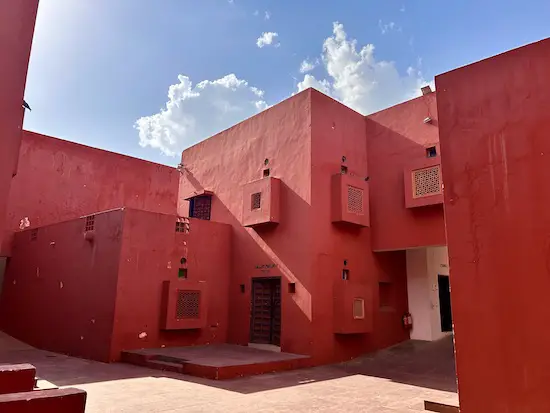
The objective of the Jawahar Kala Kendra architecture was to establish a cultural complex that seamlessly integrates with the local context and historical ambiance. As visitors traverse the lush garden and enter the courtyard, they are greeted by a succession of open-air pavilions. Passages lead to painted domes, amphitheaters, cafes, and art galleries, all arranged in a spatially aligned manner that envelopes the structure.
Notably, at the entrance to the theater, there is a mural depicting palm reading, symbolically linking astrology and astronomy by naming the planets on the mounds of the hand. The architecture, design, and activities at Jawahar Kala Kendra reflect a fusion of ancient traditions, medieval Mughal aesthetics, and contemporary artistic sensibilities, representing a dynamic and evolving cultural space.
Jawahar Kala Kendra Events:
The Jawahar Kala Kendra hosts various events throughout the year, catering to diverse artistic interests. The center is a vibrant stage for both traditional and contemporary art forms, from visual arts exhibitions to theater performances, from classical music concerts to dance recitals. It also organizes workshops, seminars, and educational programs, fostering artistic learning and exchange.
You can find a Jawahar Kala Kendra Events schedule on their official website. The Jawahar Kala Kendra Events can be found on their monthly calendar here.
The Different Sections of the Jawahar Kala Kendra:
The Jawahar Kala Kendra is based on a nine-square grid with different sections dedicated to various activities and events. The areas of the complex can be seen below:
1. Museum and Art Gallery:
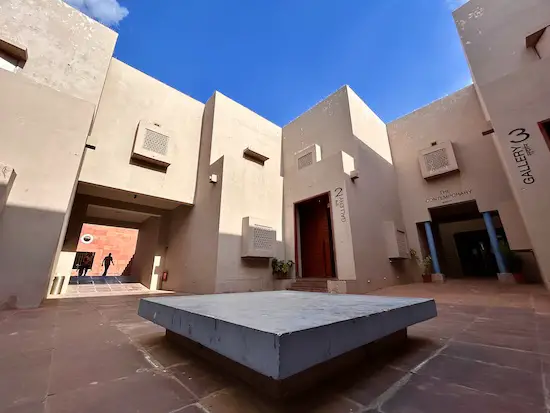
Visitors can explore the Museum and Art Gallery within the premises of Jawahar Kala Kendra. The museum showcases a curated collection of traditional Rajasthani art and artifacts, providing a glimpse into the region’s rich cultural heritage. The art gallery, on the other hand, displays contemporary artworks by local and international artists, offering a platform for artistic expression and dialogue.
It is important to note that these galleries are rotated out, showcasing new exhibits at different times. Unfortunately, this is what happened when I visited! This meant the whole Jawahar Kala Kendra museum was empty when I visited! So make sure to check out the calendar and event schedule to know if the museum and art gallery are full or not!
2. Resource Center and Library:
Jawahar Kala Kendra boasts a well-equipped resource center and library catering to the needs of artists, researchers, and students. The center houses an extensive collection of books, periodicals, and digital resources on various art forms, history, and culture. It serves as a valuable repository of knowledge, encouraging exploration and deepening the understanding of art.
The complex acts as somewhat of a school. The entire library was full of students conducting research and working on various projects when I visited. The library, however, is beautiful, with a good collection of resources and ample seating for anyone that wants to visit!
3. Open-Air Amphitheater:
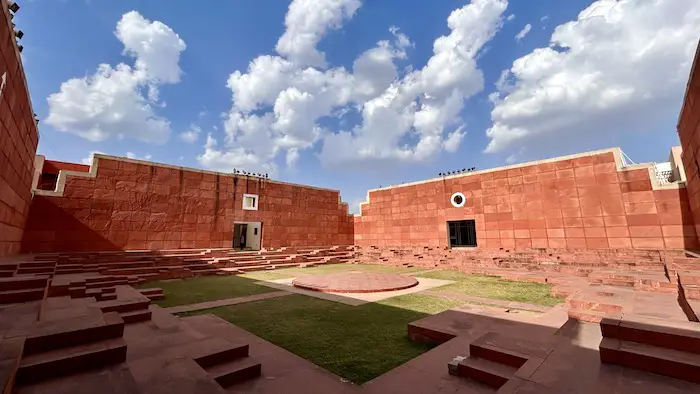
One of the highlights of Jawahar Kala Kendra is its open-air amphitheater, which can accommodate a large audience. It is a captivating venue for cultural performances, plays, and music concerts, surrounded by lush greenery, creating a magical atmosphere for both artists and spectators.
The open-air amphitheater of the JKK is the most famous part of the complex. Anytime you research the building, you will see thousands of pictures of the beautiful open courtyard in the middle. It is perfectly symmetrical, with seating all around the perimeter resembling the step wells of the region.
I absolutely loved this area, and it was a great place to take pictures, relax, and play around because of its unique design!
4. Restaurant – The Indian Coffee House

Located in the lunar section, the Indian Coffee House is operated by the Indian Coffee Workers’ Cooperative Society Limited. It is a unique platform that unveils the lesser-known facets of Indian astronomy through captivating paintings and creative expressions displayed throughout the space, including on the coffee tables. Beyond being a mere café, it also serves as a gathering place for intellectuals and art enthusiasts, who indulge in leisurely conversations amidst the aromatic blend of thoughts, coffee beans, and delectable cuisine.
I personally love the Indian Coffee House. It is a great place to relax and take in the history and culture of Rajasthan and India, all while enjoying a great (and cheap!) cup of coffee. There are two Indian Coffee Houses in Jaipur, which I have included on my list of best cafes in Jaipur!
Jawahar Kala Kendra in Jaipur: A Beautiful Architectural Museum and Art Exhibit
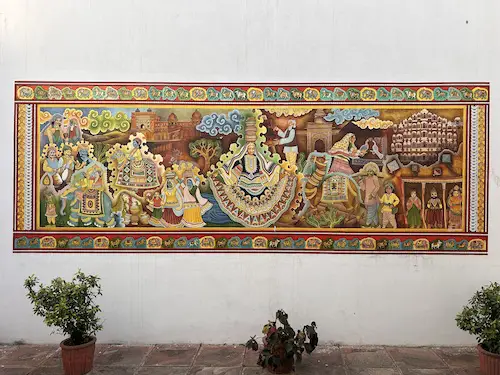
The Jawahar Kala Kendra in Jaipur stands as an embodiment of the artistic spirit and cultural diversity of Rajasthan. Its distinctive architecture, designed by Charles Correa, showcases a harmonious blend of tradition and modernity. The center’s commitment to promoting art, nurturing creativity, and hosting various events has made it a cultural landmark in Jaipur.
This was one of my favorite places to visit in Jaipur. The architecture is stunning, with the lines and symmetry of the building melting together, all while being clean-cut and stark. Moreover, it has a lot of staircases that create fascinating lines and layers in the architecture. Overall, the Jawahar Kala Kendra in Jaipur is a great place to engage in the arts of the region, as well as take photos and become your own artist!
FAQs: Jawahar Kala Kendra in Jaipur
Below are some of the most frequently asked questions about the Jawahar Kala Kendra in Jaipur, Rajasthan.
The best time to visit Jawahar Kala Kendra is in the morning, as it is an open-air complex that gets extremely hot during the day. However, the Jawahar Kala Kendra is open from 10:00 am to 6:00 pm, meaning you can visit throughout the day. A great time to visit is during the annual theater festival in April.
The material used to construct Jawahar Kala Kendra is red stone and marble.
The concept takes inspiration from the original city plan of Jaipur, the design of Jawahar Kala Kendra incorporates nine squares, with the central square intentionally left open. This architectural arrangement pays homage to the traditional layout of the city. Furthermore, it embraces the principles of Vastu Vidya, an ancient architectural philosophy, and applies them thoughtfully throughout its construction.